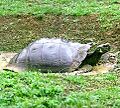Santiago Island giant tortoise facts for kids
The Santiago Island giant tortoise (Chelonoidis niger darwini) is a special type of Galápagos tortoise. It is also called the Santiago giant tortoise or the James Island tortoise. This amazing animal lives only on Santiago Island in the Galápagos. When an animal lives only in one place, it is called endemic. These tortoises belong to the family Testudinidae, which includes all tortoises and turtles.
Contents
What Happened to Their Population?
In the early 1800s, many Santiago Island giant tortoises were taken from the island by whaling ships. Later, goats were brought to the island. These goats ate so much vegetation that the coastal areas became like deserts. This forced the tortoises to live only in the middle of the island.
Protecting Young Tortoises
Sadly, there were more male tortoises than female ones. Also, many tortoise nests and young babies were destroyed by wild pigs. To help, some nests are now protected by special fences made of lava rock. Since 1970, tortoise eggs have been moved to the Charles Darwin Research Station. There, they are hatched and the young tortoises are cared for until they are big enough to be safe.
How Many Tortoises Are There Now?
Thanks to these protection programs, the number of Santiago Island giant tortoises is growing! Today, there are about 1,165 of these tortoises living in the wild.
Where Do Santiago Tortoises Live?
The Santiago Island giant tortoise prefers to live in forests and shrublands. These areas provide the plants they need for food and shelter.
What Do Santiago Tortoises Look Like?
The shell of the Santiago Island giant tortoise is called a carapace. It is gray to black in color. Its shape is a mix between the "saddle-backed" and "domed" types of Galápagos tortoise shells.
Shell Features
The front of their shell has only a small dip near the neck. The back edges of their shell stick out a little, turn up slightly, and have a few small bumps.
What Do Santiago Tortoises Eat?
The Santiago Island giant tortoise eats low-growing plants. They are herbivores, meaning they only eat plants.
Why Are They Called Darwini?
The scientific name for this tortoise, darwini, was chosen to honor a famous English naturalist named Charles Darwin. He visited the Galápagos Islands and studied many of the unique animals there.
Images for kids
See also



